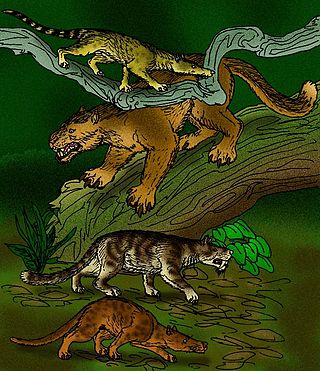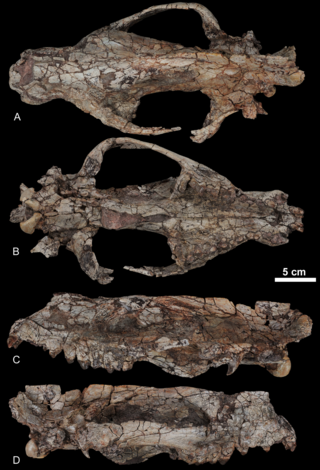
Creodonta is a former order of extinct carnivorous placental mammals that lived from the early Paleocene to the late Miocene epochs in North America, Europe, Asia and Africa. Originally thought to be a single group of animals ancestral to the modern Carnivora, this order is now usually considered a polyphyletic assemblage of two different groups, the oxyaenids and the hyaenodonts, not a natural group. Oxyaenids are first known from the Palaeocene of North America, while hyaenodonts hail from the Palaeocene of Africa.

Megistotherium is an extinct genus of hyaenodont belonging to the family Hyainailouridae that lived in Africa.

The Jebel Qatrani Formation is a geologic formation located in the Faiyum Governorate of central Egypt. It is exposed between the Jebel Qatrani escarpment and the Qasr el Sagha escarpment, north of Birket Qarun lake near Faiyum. The formation conformably overlies the Qasr el Sagha Formation and is topped by the Widan el Faras Basalt. The age of the formation has been subject to debate, but the most recent research indicates that it covers both the latest parts of the Eocene and the Early Oligocene, spanning over the boundary between these two time periods.

Pterodon is an extinct genus of hyaenodont in the family Hyainailouridae, containing five species. The type species Pterodon dasyuroides is known exclusively from the late Eocene to the earliest Oligocene of western Europe. The genus was first erected by the French zoologist Henri Marie Ducrotay de Blainville in 1839, who said that Georges Cuvier presented one of its fossils to a conference in 1828 but died before he could make a formal description of it. It was the second hyaenodont genus with taxonomic validity after Hyaenodon, but this resulted in taxonomic confusion over the validities of the two genera by other taxonomists. Although the taxonomic status of Pterodon was revised during the late 19th and early 20th centuries, it became a wastebasket taxon for other hyaenodont species found in Africa and Asia. Today, only the type species is recognized as belonging to the genus while four others are pending reassessment to other genera.
Dermotherium is a genus of fossil mammals closely related to the living colugos, a small group of gliding mammals from Southeast Asia. Two species are recognized: D. major from the Late Eocene of Thailand, based on a single fragment of the lower jaw, and D. chimaera from the Late Oligocene of Thailand, known from three fragments of the lower jaw and two isolated upper molars. In addition, a single isolated upper molar from the Early Oligocene of Pakistan has been tentatively assigned to D. chimaera. All sites where fossils of Dermotherium have been found were probably forested environments and the fossil species were probably forest dwellers like living colugos, but whether they had the gliding adaptations of the living species is unknown.

Hyaenodonta is an extinct order of hypercarnivorous placental mammals of clade Pan-Carnivora from mirorder Ferae. Hyaenodonts were important mammalian predators that arose during the early Paleocene in Europe and persisted well into the late Miocene.

Hyainailouridae ("hyena-cats") is a family of extinct predatory mammals within the superfamily Hyainailouroidea within extinct order Hyaenodonta. Hyaenodontids arose during the middle Eocene and persisted well into the middle Miocene. Fossils of this group have been found in Asia, Africa, North America and Europe.

Teratodontinae is a subfamily of extinct hyaenodonts. Fossil remains of these mammals are known from Middle Eocene to Late Miocene deposits in Africa, the Arabian Peninsula, and Asia.
Isohyaenodon is an extinct polyphyletic genus of hyainailourid hyaenodont mammal from the subfamily Hyainailourinae). Remains are known from early to middle Miocene deposits in Kenya, East Africa.
Exiguodon is an extinct genus of hyainailourid hyaenodont mammal of the subfamily Hyainailourinae. Remains are known from early Miocene deposits in Kenya and Uganda, in East Africa.

Metapterodon is an extinct genus of hyainailourid hyaenodonts of the subfamily Hyainailourinae, that lived in Africa during the early Oligocene to early Miocene. Fossils of Metapterodon were recovered from the Egypt, Uganda, Elisabeth Bay Formation in Namibia, and Rusinga Island and Karungu in Kenya.
Sectisodon is an extinct genus of hyainailourid hyaenodont mammal of the subfamily Hyainailourinae from early Oligocene to early Miocene deposits in Egypt and Uganda.

Metasinopa is a genus of teratodontine hyaenodont that lived during the early Oligocene in Egypt.
Orienspterodon is an extinct genus of hyainailourid hyaenodonts from paraphyletic subfamily Hyainailourinae that lived in China and Myanmar during the middle to late Eocene. Orienspterodon dahkoensis was originally assigned to genus Pterodon in 1975, but was eventually assigned to its own genus in 2007.

Hemipsalodon is an extinct genus of hyainailourid hyaenodonts from the subfamily Hyainailourinae that lived in North America during the middle to late Eocene.

Kerberos ("Cerberus") is an extinct genus of hyainailourid hyaenodonts in the subfamily Hyainailourinae, that lived in Europe. It contains the single species Kerberos langebadreae.

Dissopsalini is an extinct tribe of teratodontid hyaenodonts. Fossil remains of these mammals are known from early to late Miocene deposits in Asia and Africa.

Apterodontinae is an extinct subfamily of hyainailourid hyaenodonts that lived in Africa and Europe during the late Eocene to middle Oligocene.

Hyainailourinae ("hyena-cats") is an extinct subfamily of hyainailourid hyaenodonts that lived in Africa, Asia, North America and Europe from the middle Eocene to middle Miocene. They appeared in Africa about 47.8 Ma ago and soon after spread as far as East Asia.
Palaeohodites is an extinct genus of primate from the Eocene Nadu Formation of China. Living about 35 million years ago during the late Eocene, Palaeohodites belongs to an extinct group of primates known as adapiforms, related to modern day lemurs and lorises. Specifically, this genus is one member of the family Ekgmowechashalidae, known primarily from the Eocene and Oligocene of Asia. Notably, Palaeohodites has been recovered as the sister taxon of Ekgmowechashala, the latest primate known to exist in North America before the arrival of humans at the end of the Pleistocene.











